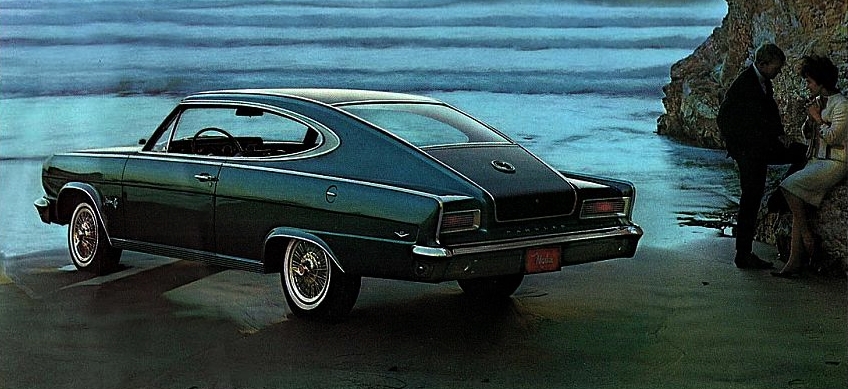
If you’re in the market for a midsize car today, you have plenty of choices. Well, for now, as the ever present crossover is rapidly compelling the manufacturers to kill off the traditional midsize sedan. Several nameplates from which to choose–Camry, Impala, Fusion and Optima and of course Accord, to name a few. And they all come in the same flavor of competent albeit repetitive design and styling. Where’s the flair, man? Once upon a time, before safety standards, emissions and plain old public demand trumped style, a buyer could get virtually whatever their heart desired, right down to colors, options–and yes, Virginia, even a body style other than the now-ubiquitous four-door sedan. Want an aqua Skylark convertible with a white interior, V8 and four-speed? Done! How about a red Lark Wagonaire with a red interior, 350 McKinnon (nee GM) V8, power retractable roof over the cargo area, and automatic transmission? No problem. You could have those cars and everything in between–in 1965. Everything from cheapskate beige two-door post with manual everything to fully loaded sports convertible with a fire-breathing powerplant. So let’s set the way-back machine to Autumn 1964 and see what we can get.
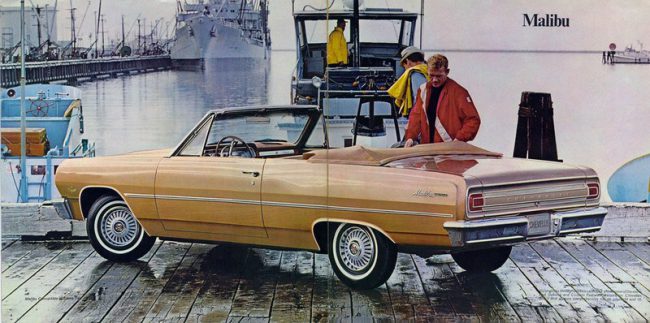
The Chevrolet Chevelle, naturally famous and fondly remembered in 2018, was the new kid on the block in 1965. It was its second year of existence on the Chevrolet roster, and sales were, by any standard, healthy. For folks who’d tired of the middle-aged spread of Chevy’s full-sizers, the Chevelle (and flossier Malibu) provided a breath of fresh air for those longing for the dimensions of the 1955-57 Chevrolets.
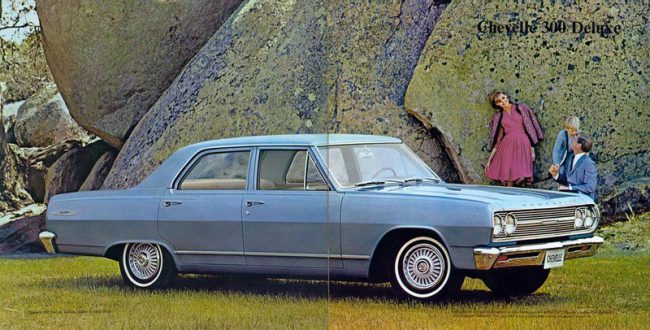
If you bought a Chevrolet in the 1965 you couldn’t go wrong. Seriously. They were well-built, had stout mechanicals, and there was a friendly Chevrolet dealer in almost every burg you’d care to pass through. Chevy was the 800 pound gorilla of GM, and buying one was as natural in the U.S. as summer baseball, neighborhood barbeques and going down to Kresge’s for bargains. Buyers spoke with their wallets and snapped up over 31,000 Chevelle 300s, 37,500 Chevelle/Malibu wagons, 41,000 300 Deluxes, and 152,200 Malibus in 1965.
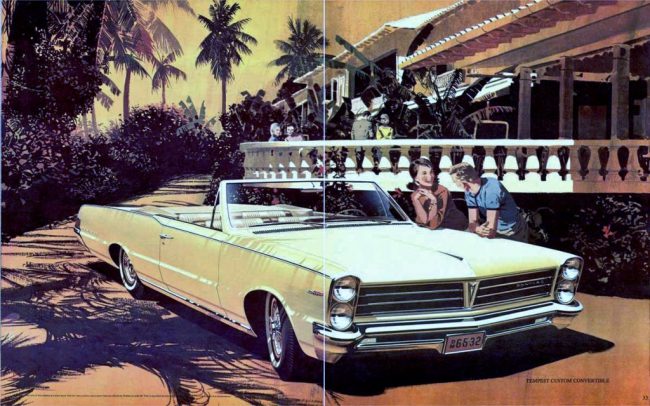
The next step up the ’65 GM mid-size ladder was Pontiac’s Tempest/LeMans series. While the Chevelle was handsome enough, it was a tad plain. The LeMans, however, was a knockout. Stacked headlamps, smooth, Coke-bottle flanks and Pontiac’s hail-fellow-well-met reputation were all good reasons to splurge for one of their intermediate offerings. And who doesn’t love Van and Fitz brochure artwork?
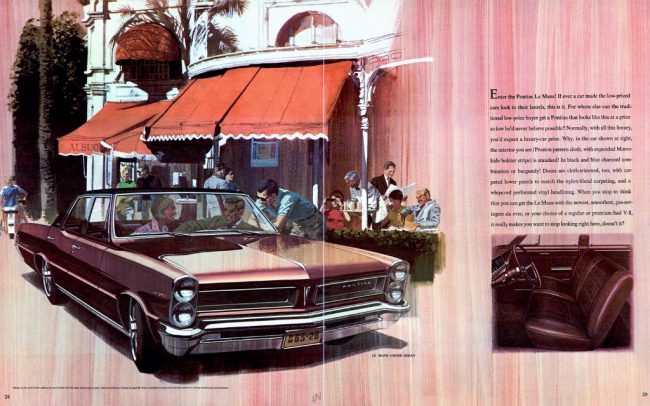
Oh, it would be so easy to pick out a GTO hardtop or convertible, wouldn’t it? But believe it or not, the GTO was not the only mid-size Pontiac, though you could be forgiven that when attending today’s car shows and cruise-ins. Yes, there were two doors, four doors, hardtops and wagons aplenty, in Tempest, Tempest Custom, and LeMans flavors. And, of course, the GTO. When the model year closed out, 39,525 Tempests, 84,653 Tempest Customs, 107,553 LeMans, and 75,352 GTOs found happy new owners.
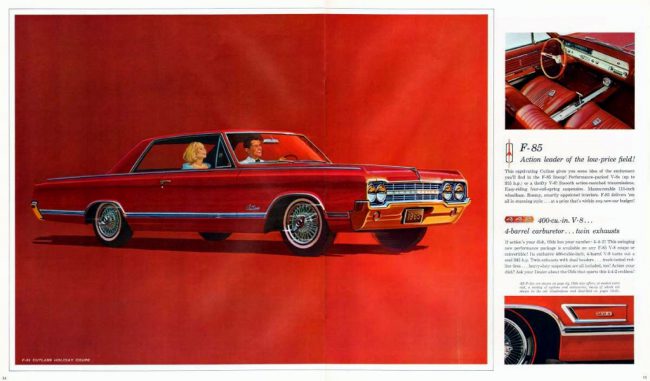
Less seen these days than the Malibu and LeMans, at least at the usual summertime car shows and cruise nights, the Oldsmobile F-85 and Cutlass nonetheless handsome midsizers. Just as stepping from a Chevy to a Pontiac got you more appointments and special touches, moving from Pontiac to Olds also bumped you to a nicer car. Oldsmobile was a great car in the ’60s, though somewhat under the radar when compared to its brassier Buick and Cadillac sisters. To those in the know, however, the Olds was a fine car and a great value. The F-85 and Cutlass were no exceptions.
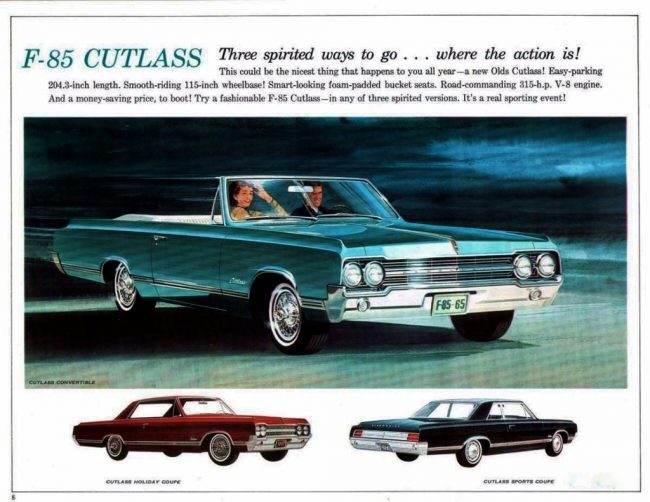
As with the GTO, Olds’ sporty 442 model debuted the year before, in 1964. Though not (yet) as well-known as a hot car, the 442 did get a bit more noticeable from its F-85 siblings in ’65, with optional redline tires and a simulated brake duct with 442 emblem. By 1968, the 442 would be right up there in popularity with its Chevelle SS396, GTO, and Buick GS muscle car relatives.
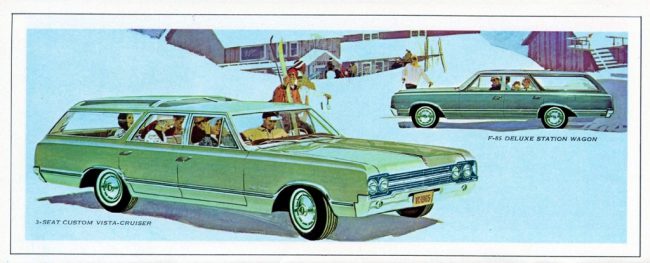
Of course, I HAVE to mention the unforgettable Vista Cruiser! In only its second year of production, the stretched-wheelbase F-85 wagon replaced the big Olds wagon in the lineup until the Custom Cruiser debuted in 1971. The Vista Cruiser itself lasted through 1972 with that cool roofline, to be replaced with a less distinctive pop-up sunroof in 1973-77 Colonnade wagon guise. Of course, you could get a regular wheelbase, non-Vista-windowed F-85 wagon too. But why would you want to? Of the F-85, F-85 Deluxe and Cutlass trims, the Cutlass reigned supreme (pun intended) in the sales charts, with 85,207 built. F-85 and F-85 Deluxe production was 24,969 and 69,921, respectively. Vista Cruiser was the most popular wagon too, with 31,985 made.
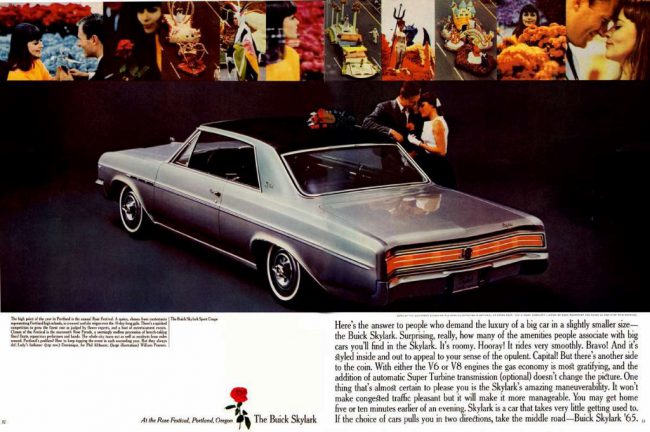
The top of the heap in GM midsizers was Buick’s Special and Skylark. Introduced in 1961 as a “senior compact” along with the Tempest and F-85, all had graduated to official mid-size status in 1964. Specials came standard with something unusual in a 1965 U.S. car: a 225 CID V6 engine. With 155 hp and breathing through a two-barrel Rochester carburetor, no less. Of course, if Buick buyers in Minneapolis, Omaha and elsewhere were thrown by the idea of a V6, a 300 CID V8 with 210 hp could be fitted instead.
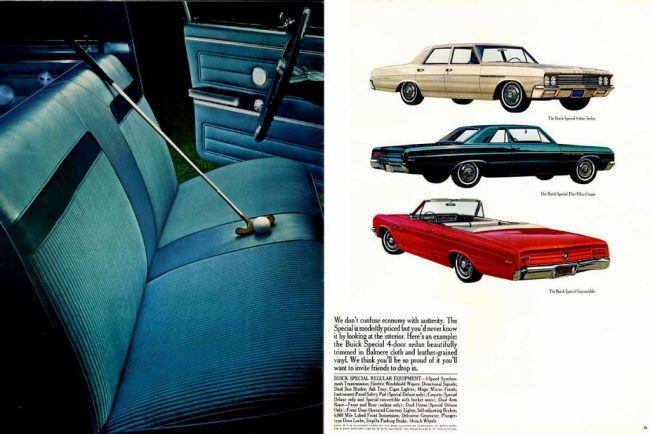
The mid-size Buick came in three flavors: Special, Special Deluxe and Skylark. I don’t know why, but the Special Deluxe moniker always makes me think of store-brand coffee. Anyway, the Skylark did well, actually outselling the F-85, with 53,469 Specials, 47,436 Special Deluxes, and 104,532 Skylarks made. Not bad, when you consider that a Buick intermediate sold for approximately $300 over an equivalent Chevelle Malibu. However, $300 was not chump change in 1965. It’s all a matter of perspective. I don’t want to be one of those fake-happy bloggers going, “LULZ the ’65 Special, is, like totally bogus compared to an ’18 Civic!” Context is the watchword!
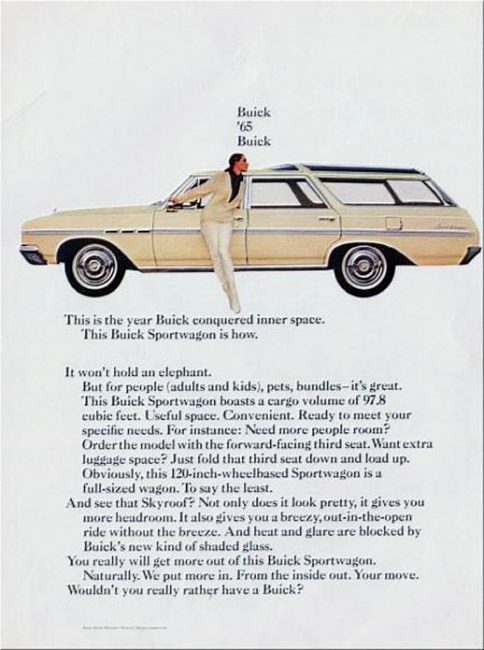
The Buick version of the Vista Cruiser, the Sportwagon, also did pretty well for a premium midsize station wagon, with 28,356 built. I have a hard time deciding whether I like the Olds or the Buick wagon better. I guess I have to give the edge to the Olds, though I wouldn’t kick either one out of the garage.

Moving away from 800-pound gorilla GM, let’s see what FoMoCo has on offer. The 1965 full-size Ford was a sharp car. My Grandpa Fred bought one new, a Galaxie 500 four door sedan in pale yellow. But that’s outside our purview for today, so the Fairlane is it from the Blue Oval. As you can see, Ford stylists tried to take the sharp ’64 Fairlane and add ’65 Galaxie styling cues to it. The result is rather blocky, though still good looking in my humble opinion.
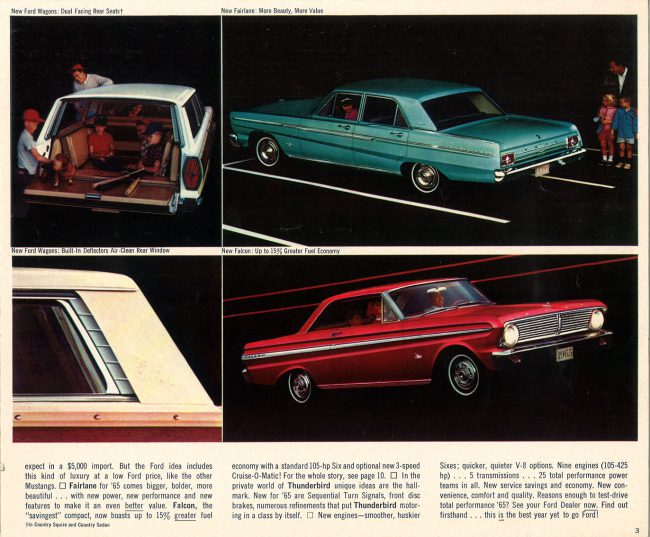
Available in Fairlane and Fairlane 500 versions; 52,974 base versions and 170,980 500s came off the line before the year was out. This was the last year of the “original” Fairlane; in 1966, an all-new Fairlane line would debut. Like the 1964 GM A-bodies, they would be bigger and better than before.
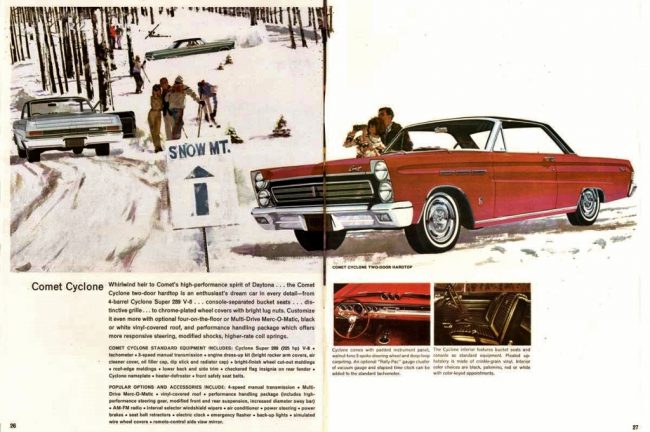
If you wanted a Ford product but desired a bit more finesse in styling after looking at the Fairlane’s somewhat overly rectilinear schnozz, your only choice was the Mercury Comet. Yes, it was still strictly a compact in 1965, but I’m including it here because having the Fairlane as the sole FoMoCo entry was just a little lacking against GM’s mid-size A-body juggernaut.
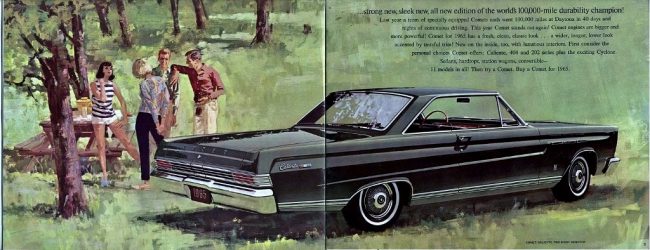
Although the side sculpturing of the ’65 was a little busy, the stacked quad headlights and simple horizontal grille were handsome indeed. And for you sporty types, you could get a Comet Cyclone hardtop with 200-hp, 289 CID V8, four speed, extra gauges on top of the dash, and wheel covers with the look of reverse chromed wheels. All in all, a nice ride.
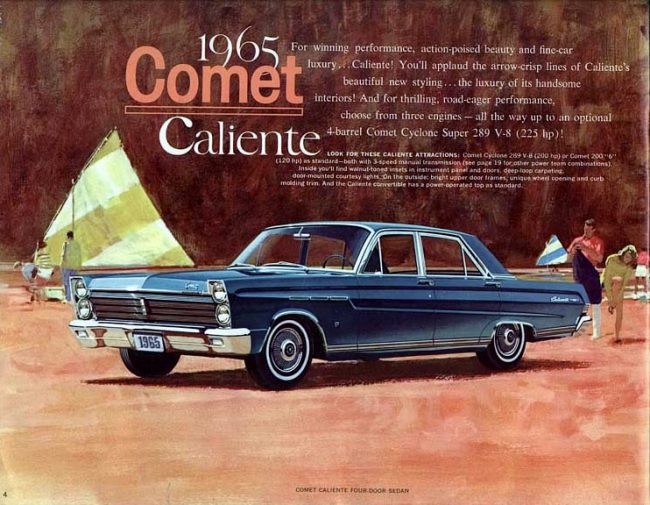
For the more buttoned-down set, a Comet Caliente sedan could be just the ticket. 1965 Comets came in base Comet 202, Comet 404, high-line Caliente, and sporty Cyclone variants. Of course, a Villager wagon with Di-Noc woodgrain siding was available too, though quite rare with only 1,592 sold. A grand total of 165,052 Comets saw the light of day for 1965.
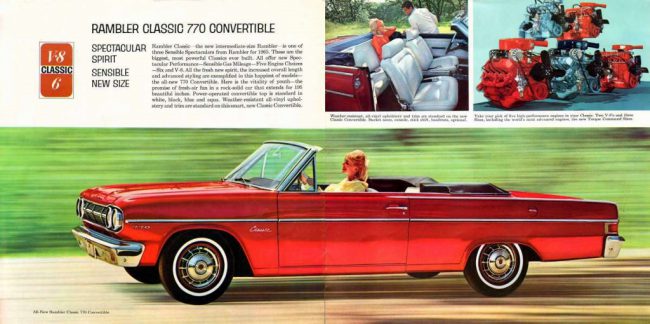
And now we come to venerable Rambler. Rambler came out with an all-new Classic in 1963, but by 1965 it was time for a major facelift. You can still see the ’63 in the roofline of the coupes and sedans, but all in all the ’65 had the appearance of an all-new car. Heck, it was years before yours truly realized it was a heavy facelift rather than an all new car! The rear deck was extended by several inches for a much more capacious trunk, and lines were generally more squared-off, in the fashion of the times.
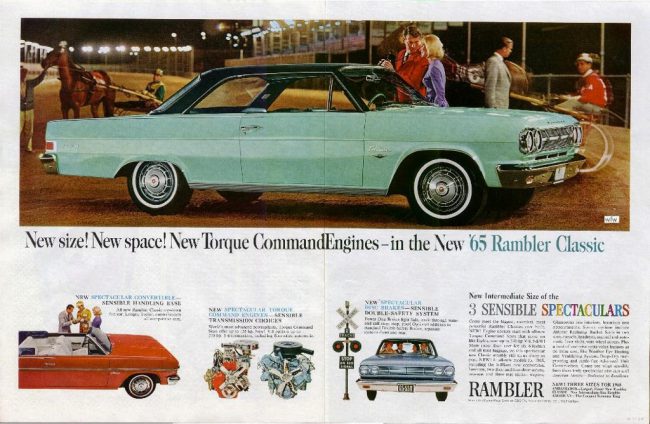
The 770 series and sporty 770H hardtop were the top of the line. The 660 was the bread-and-butter model, with the 550 being the skinflint/frugal person’s choice. Five different body styles were offered, including a new convertible in the 770 series.
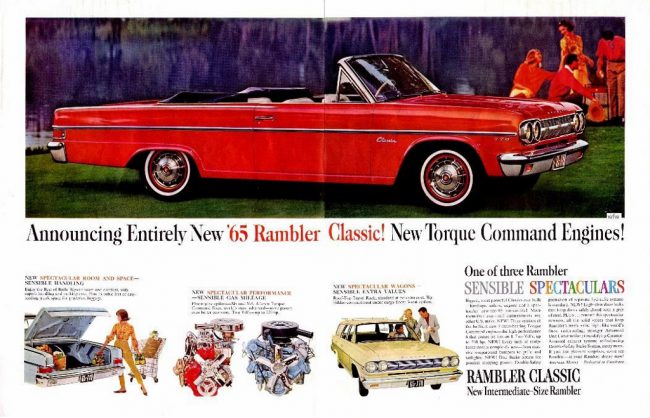
The convertible was particularly handsome, and when equipped with the premium-only 327 CID, 250-hp V8, quite speedy. Sadly, only 4,953 770 cabs were made. For the more frugal set, a 126-hp 199 CID Six was standard in the 550, with a 145-hp 232 Six standard in all other Classics. A 287 CID, 198-hp V8 was also available, and did not require premium fuel.
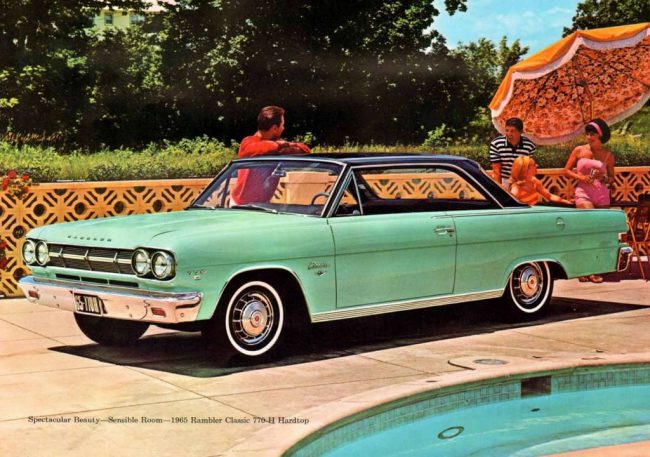
Yes, the 1965 Classic was a nice car, but GM had been eating Rambler’s (and Studebaker’s) lunch since the 1961 debut of the Tempest, F-85 and Special. Though as a whole Rambler didn’t have a bad year, it wasn’t as good as expected, considering the huge expenditure in new styling for not only the Classic, but the Ambassador, now wearing distinctive front sheetmetal and riding a newly stretched wheelbase.
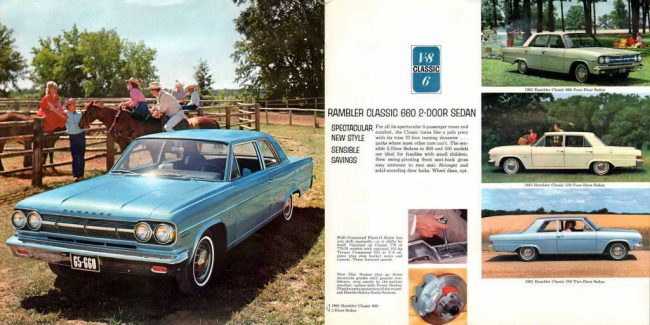
When all was said and done, 51,350 550s, 87,643 660s and 64,663 770s (including 5,706 770H hardtops) were made. Rambler made money for the year, but when you compared 1965 calendar year sales of 346,367 against 393,863 for the year prior, you could tell that there could be trouble ahead. In fact, the 1965 Classic would be the next-to-last last new mid-size Rambler ever, as the refreshed 1967 model essentially lasted all the way to 1978 as the AMC Matador.
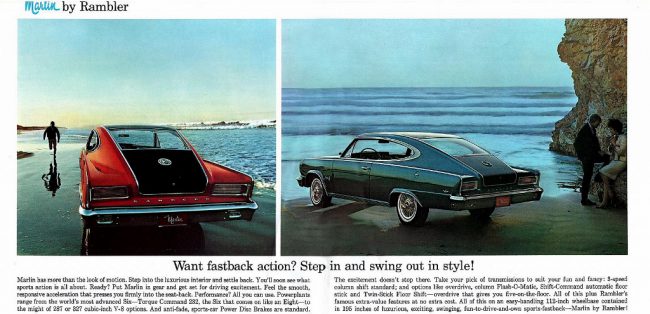
Of course, I have to mention the Marlin, which was basically a Classic fastback pony car-or trying to be one anyway. It debuted in February 1965 as a mid-year addition. There’s a reason most advertising shows it from the back and at an extreme three-quarter view. In side view, this car was a little bit awkward. Yet I love them! Engine options were about the same as the Classic, as you’d expect. This car did not find many takers, with only 10,327 built in its short model year. Mustang Fever was in swing, and not too many were looking for an AMC alternative.
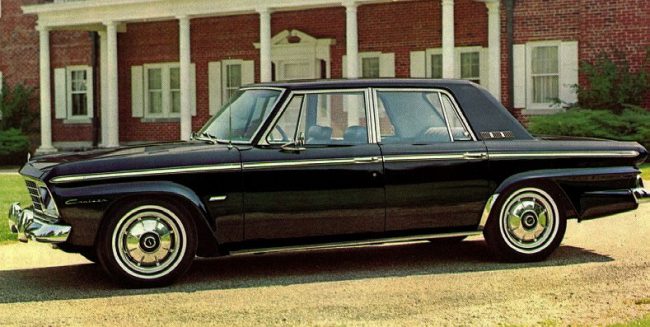
And now we come to Studebaker. By 1965 I suppose most people outside of Indiana (and Hamilton, Ontario) didn’t know that Studebakers were still made, albeit in Canada. Yes, the ’65 Studeys were imports, powered by McKinnon Chevy Sixes and V8s.
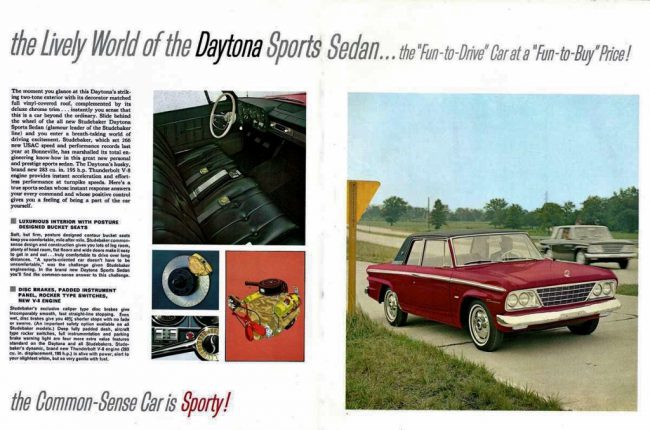
The Avanti, Lark hardtop, Lark convertible and GT Hawk were all sadly departed, but you could still get a Daytona Sports Sedan or Wagonaire.
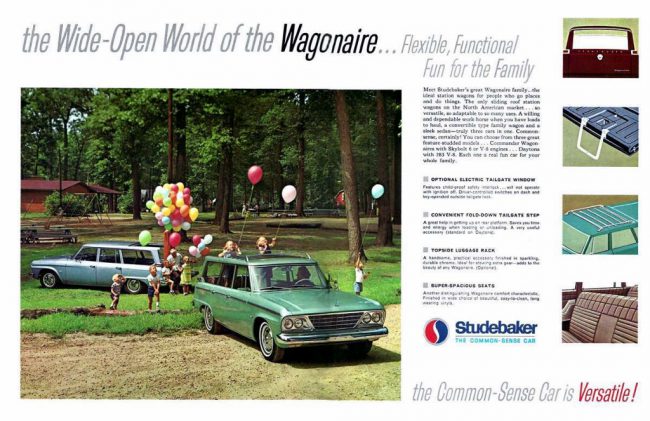
Commander two- and four-door sedans, a Commander Wagonaire, and and top-trim Cruiser sedan rounded out the line. Daytonas were available only with the 283 CID, 195-hp V8, while Commanders and Cruisers came standard with a 194 CID, 120-hp Six. And yes, I suppose these were more compact than mid-size as well, but I have to do my part to spread the Studebaker love!
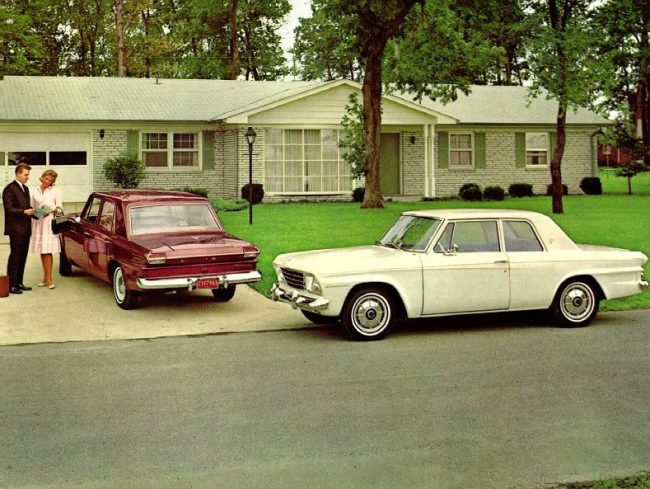
It was a sad ending for what could have been. Studebaker was at times its own worst enemy, and in 1965 it was more true than ever. After automotive division champion Sherwood Egbert was forced to retire, the remaining Studebaker board summarily wiped out the auto division shortly after the 1966 models’ production began. 1965 Studebaker production was predictably minor, with only 10,699 made. The most popular model was the Commander four-door sedan, with 4,344 produced.

Dodge got a default mid-size in 1965, as a clean-sheet, “real” full-size 1965 Dodge replaced the 1962-64 “shrunken” Dodges. So what did Chrysler do with the old model? Why, they simply facelifted it and reintroduced it as the “new” midsize Coronet! Actually, it was a no-brainer, as the 1962-vintage platform was the perfect size for an intermediate. Why not give it some new sheetmetal and reinvent it, and save millions on developing an all-new midsize model? Coronets came in base Coronet, mid-line 440 and fancy-schmancy V8-only Coronet 500 trim, with the usual assortment of coupes, sedans, hardtops, wagons, and a convertible.
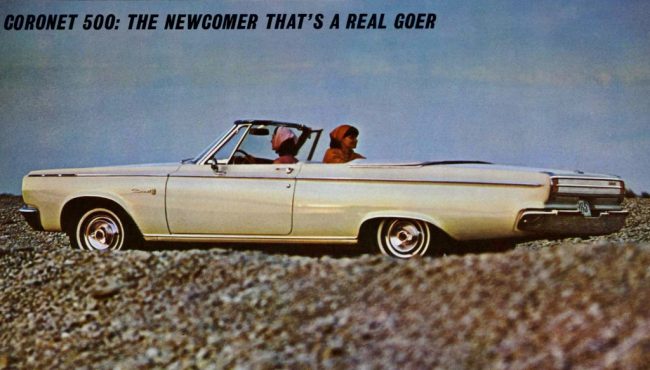
1965 Coronets sold decently, with about 63,100 Coronets, 37,500 440s and 33,300 500s made.
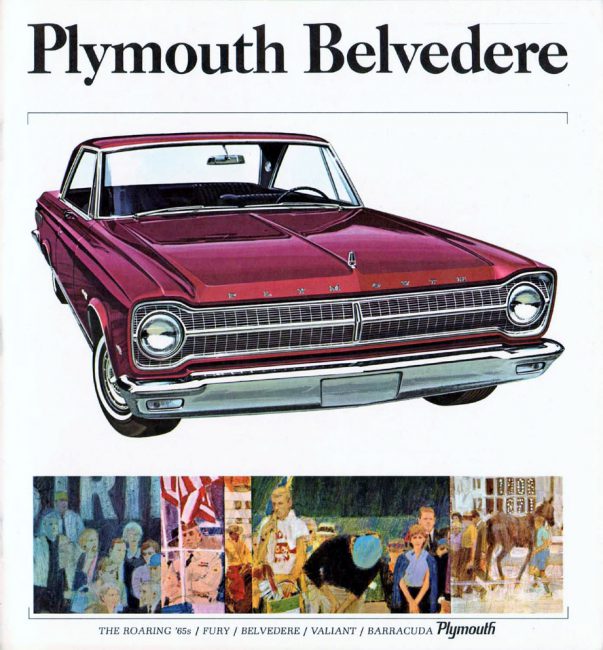
If your Mopar love ran more towards Plymouth than Dodge, you had your pick of Belvederes: Everything from a red Satellite convertible with bucket seats and V8 to a pea-green, Slant Six four-door sedan that your librarian Aunt Sissy would just love.
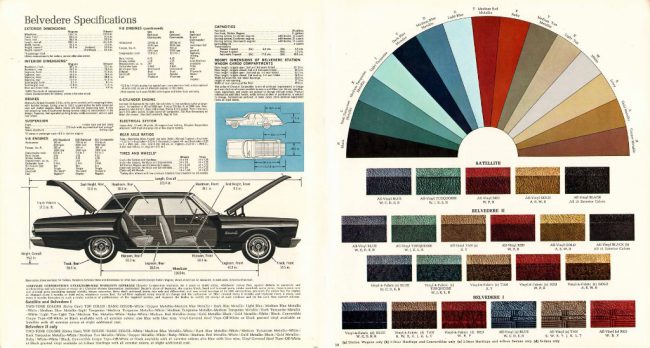
In 1965, Chrysler was pulling itself out of the hole it had dug with the 1957 models.
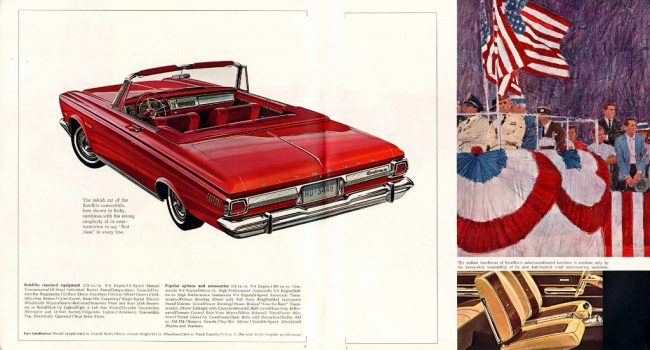
By 1965 they’d been working hard to improve quality for several years. And all their models, from Valiant to Imperial, were pretty solid cars now.

As you can see, the Belvedere and Coronet had quite a bit in common, though that wasn’t all bad, especially in the hardtops, with that cool reverse-angle C-pillar. Somehow I prefer the Plymouth to the Dodge. It just looks cooler to me. Belvederes came in Belvedere I, Belvedere II and upper-crust Satellite trim levels. All told, 159,335 Belvederes and Satellites of all types came off the line in ’65.
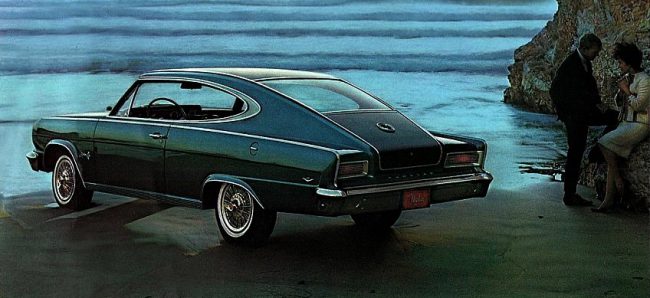
So now we’ve come to the end of the lineup. Lots of tempting choices, eh? It would be easy to pick a LeMans convertible or Skylark hardtop, but I have to go with the road less traveled. I’ve always admired the 1965-66 Rambler/AMC Classic, and I will have to go with one of the “Sensible Spectaculars.” Give me a dark aqua Marlin. Yes, really. With either an aqua or white vinyl interior, whitewalls, wire wheel covers, automatic and the 287 CID V8 (don’t want the 327, as it takes premium). Which one would you pick?







13 Comments
Interesting. My parents bought a brand new 1965 Chevelle Malibu off the showroom floor of Don Wheaton Chev Olds Cadillac which still exists at the same Whyte Ave location today in Edmonton, Alberta. 230 I-6 with Powerglide, whitewalls and deluxe wheel covers…no other options. Dad wanted a Belair, having owned a 55 Chev 210 but when he took Mum to see it she disliked the styling and spotted the Malibu and said “I want that one.” More than ample for a family of four, we had it until 1970.
65 was a great year for cars but I personally think 66 might be just a bit better as the improved Novas debuted. Of course the Chevelle got some bloat and the Impala lost it’s six round taillights do it might be a push.
Great article Tom, makes we feel like we have a lot more brands from a Lot more places these days, but a lot less vehicles I’d actually like to own.
Great pictorial. At least for GM, I think you could argue 1965 was the all-time peak – with the big exception of the true Mustang competitor, a GM model was the best car in every segment with the next 2-3 best probably from other GM division rivals. Even against the very popular Mustang, I would have chosen the better engineering and handling (and nice styling) of the Corvair Corsa. Coupe DeVille, Riviera, Cutlass Vista-Cruiser, GTO, Bonneville, Corvette, Corvair – top to bottom GM had the merchandise in 65.
quick somebody stop the rambler from drving into the pool!
i’ll take the vista cruiser? does it come with the two way tailgate? who am i kidding. i’d probably get a chevelle wagon like me dad’s with a straight six and three on the tree.
From the car companies’ “Hey, you can’t park there!” series. 🙂
Memories. 1965 is memorable for several reasons: First, it was when I, at age 7, first started noticing cars. Second, ten years later, these were the choices for high-school-kids’ cars. To my mind, as to yours, there was incredible variety – everything from the smooth, well-designed-but-bland GM mid-sizes, to the cubist MoPar offerings – and of course the four-leaf-clover for the nerdy, the Studebaker. There were still a few on the ground when I was a newly-minted driver; but as my father was struggling with one of the last Kaisers, a 1969 Wagoneer…he’d have shot me dead if I brought another off-brand home.
Ramblers, I remember, as in their first nadir of popularity – after the early-’60s explosion, but before their last stand with the Hornet/Concord/Gremlin/Spirit. They were just THERE – no self-respecting kid would be seen in one, much less driving one. A Stude would be cooler.
The Belvedere, I remember for an entirely-different reason. The high school I went to…a senior boy, three years older…a jock, on the football and wrestling teams…had a two-door Belvedere sedan, great shape, lightly customized with mags and a red stripe down the character line on the sides. I remember it well, because the frosh teen-queen, the star of a thousand erotic night-dreams of our classes, used to jump into that every afternoon. The two were an item.
Interestingly, today, I was going through a local business’s parking lot, and there sat a 1930s pickup truck. It was in a primer coat and shorn of all badges; and no hubcap stampings. I thought, perhaps, it was a Ford, with the shape of the grille…whether a converted Tudor or an actual BB truck, I don’t know.
I don’t even know if it was a Ford. Could have been a Chevrolet grille on that thing…I was thinking, hard to say. All the cars from that era all looked alike, mostly.
Then I looked around, at the sea of modern blobmobiles…about half of them, white…only Fords and Mazdas even trying to buck the trend…you could basically say the same thing about today’s cars.
But, the 1960s. THAT was when cars had CHARACTER, each in its model.
I have 2 favorites. The Olds Cutlass hardtop with the 330 V8, 3 speed auto and the full load of lux options. The drivetrain ease and the GM ability to give you just the way you want it at a good price was at its zenith.
Also the Chevelle in i’s absolute base form with the superthrift 6 and 3 on the tree. This austerity model still shows so much superiority in terms of room for the large families we still had then combined with a smooth inline six with tall enough gearing to actually be used on the new interstates. Think of the tiny underpowered deathtraps middle class families in Europe and Japan were stuffing themselves into.
As for knowing my weirdness what I would have actually bought. It would have been a contest between the Studebaker that would have lessened my worry about its future with the switch to Chevy engines. That or see if one of those fly by night import dealers at the edge of town had a left over last year Humber Super Snipe, or a Farina body BMC with those 3 liter inline sixes with the 4 speeds with electric overdrive and the real wood and leather interior. All so I could pretend I was a threadbare member of the English aristocracy. I would have had to play TK in looking for aftermarket kits for AC and cruise control in JC Whitney.
I like the Cutlass too, but there was no 3 speed auto in any GM intermediate until 1967 when they started putting the Turbo 400 in the performance models, automatics had to make due with the ST200 2 speed Hydramatic(not a Powerglide).
That burgundy Olds Cutlass coupe caught my eye too.
You are correct, had always thought the “jetaway” was a three speed.
I would have never made it past the GM dealers.
The impractical side of me would go for the red GTO convertible with a 4 speed. Realistically, a nice LeMans hardtop coupe with the 326 and a 4 speed, through in some a/c, cause its hot down here.
Although, that Cutlass Hardtop is tempting, as is the Skylark, I like the Skylark ad with its photo-montage at the top and the Skylark has that funky vinyl top that only runs down the top of the roof.
I dig the cool burbs house with the 2 Larks, the house seems a little fancy for the Studebakers, maybe they were emphasizing how much more house you can get when you spend less on a Lark?
I like the blue Fairlaine sedan in the black parking lot abyss of nothingness…..”where the hell did you kids go? I told you not to wander into the inter-dimensional black hole!!!……we’ve been waiting here for 30 minutes!”
I learned how to drive in an International pickup truck, late 1950s variant. I was 8 years old. But I got my driver’s license in a Ramble Classic, with three on the tree.
I owned a 1965 Dodge Coronet 440 with tons of chrome; looking at prices for them now I wish I’d kept it. That had the push-button transmission mated to a 318.
I’d love to have a Vista Cruiser nowadays. I think the station wagons have been overlooked in these days of SUVs, CUVs, XYZs….. There’s not much styling nowadays as was pointed out many times on this website; aerodynamics being the prime driver of style.
Another great article, Tom.
Something I noticed… I don’t think McKinnon made anything bigger than the 283; a 350 in a Lark would have been a Chariot of the Gods.
Lately I’ve been on a real Mopar and AMC 6 cylinder kick lately, but none of the 65 AMCs you feature here do anything for me. Now, the Rambler American with the 199 and a three on the tree would be fun. I like the Belvederes and Coronets but the Leaning Tower of Power did a lot better in a Dart. The Studey Daytona with the 283 would be great, too. My Mercury upbringing has me eyeing the Caliente… But, the LeMans with a 326 and an autobox would probably be my choice out of this offering.